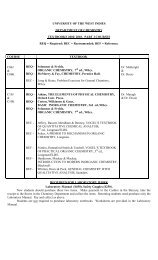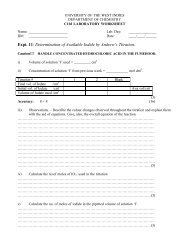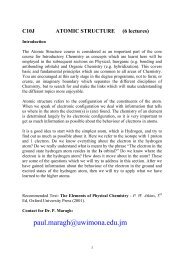faculty of pure and applied sciences - The Department of Chemistry ...
faculty of pure and applied sciences - The Department of Chemistry ...
faculty of pure and applied sciences - The Department of Chemistry ...
You also want an ePaper? Increase the reach of your titles
YUMPU automatically turns print PDFs into web optimized ePapers that Google loves.
O-29 NUMERICAL SIMULATION OF GALACTIC MERGERSJ. Lodenquai <strong>and</strong> C. McNamarah<strong>Department</strong> <strong>of</strong> Physics, MonaRadio-loud active galactic nuclei (AGNs) are elliptical galaxies that emit unusually largeamounts<strong>of</strong> non-thermal electromagnetic radiation (EMR) over a wide spectrum. <strong>The</strong> merger hypothesispostulates that an AGN can form from the merger <strong>of</strong> two spiral galaxies containing supermassiveblack holes in their cores.During merger, some amount <strong>of</strong> matter eventually falls onto each black hole, just outside itsSchwartzschild radius, forming an accretion disk. Differential rotation within the accretion diskresults in the transformation <strong>of</strong> a significant fraction <strong>of</strong> the mass <strong>of</strong> the disk into the EMR observedfrom AGNs.In this paper, the merger <strong>of</strong> spiral galaxies is studied numerically. Each spiral galaxy is assumed tohave (i) a spheroidal halo <strong>of</strong> dark matter (ii) a spiral disk consisting <strong>of</strong> stars <strong>and</strong> gas <strong>and</strong> (iii) aspheroidal nucleus containing stars <strong>and</strong> gas with a supermassive black hole <strong>of</strong> mass about ten millionsolar masses in its core. Previous simulations, which used simplified models [Bekki <strong>and</strong> Noguchi(1994), Bekki (1995)], claim to be able to explain the onset <strong>of</strong> AGN-behaviour during the merger.However, the present work does not find that the energetics <strong>of</strong> AGNs can be accounted for duringmerger. However, sufficient infalling matter onto the black holes could occur considerably later aftermerger.Videos <strong>of</strong> typical merger simulations are presented.ReferencesBekki, K. & Noguchi, M. (1994). Gas fueling to the central 10pc in merging galaxies. Astron.Astrophys. 290: 7-18.Bekki, K. (1995). Gas dynamics <strong>of</strong> the central 1 kpc in galaxy mergers. Mon. Not. R. Astron. Soc.276: 9-19.O-30 LIMITED AREA NUMERICAL ATMOSPHERIC MODELINGFOR THE EASTERN CARIBBEANM. Mayers, C. Depradine 1 <strong>and</strong> L. L. Moseley<strong>Department</strong> <strong>of</strong> Computer Science, Mathematics <strong>and</strong> Physics, Cave Hill;1Caribbean Meteorological Institute, St. James, Barbados<strong>The</strong> objective <strong>of</strong> our research is to contribute to the development <strong>of</strong> a general limited areaatmospheric model appropriate to the Eastern Caribbean region. We will modify <strong>and</strong> extend existingmodels, where possible, to include phenomena ranging from weak tropical waves to hurricanes, <strong>and</strong>flooding due to rainfall, storm surge <strong>and</strong> wind generated waves. Current models are generally notwell tuned for our peculiar conditions.49










